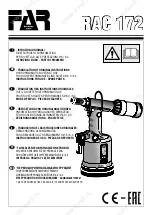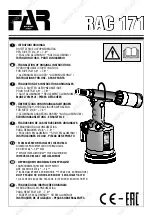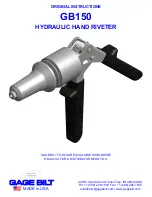
Cap Iron Bevel
Blade
Cap Iron Micro-Bevel
Blade Clamping
Clamp the blade into position with the lever cap knob.
Caution:
Th
e lever cap knob has tremendous
mechanical advantage. For normal use, it needs to be
tightened only a quarter turn aft er full engagement with the
blade.
Never
torque it down as hard as you can, or you may
damage the plane.
How to Make Fine Shavings
The quality of the shavings is determined by the blade
projection, the blade skew and the mouth opening.
Adjusting the Blade Projection and Blade Skew
With the plane assembled, but the blade not cutting,
loosen the lever cap knob. Place the plane on a board
and slowly advance the
blade by turning the
adjuster knob clockwise
(when viewed from the
rear; see
Figure 8
), and
take a test cut. To retract
the blade, turn the knob
counterclockwise farther
than required (to take up
any slack in the adjuster),
and then advance the blade
to the new projection.
A skewed blade cuts more
heavily on one side of the
plane than the other. In
a properly set plane, the
cutting edge is parallel to
the sole of the plane. If
the shaving is not centered
in the mouth, shift the
adjuster knob (left or right)
in the direction in which
the shaving is thickest.
Close the mouth until it
is approximately
1
/
32
"
(0.8mm) wide. Continue
to advance the blade until
it is taking shavings as
required by the work.
To prevent the blade from
shifting sideways, adjust
the set screws on either
side of the mouth until
they just touch the blade,
not to clamp it, but to
create a guide.
3
The distance from the leading edge of the cap iron to the
cutting edge of the blade should be about
1
/
64
"
(less than
0.5mm). A smaller offset will yield better results, but the
plane will be more diffi cult to push. A larger offset will
have the opposite effect: easier to push, but possibly more
tear-out. Only you know which wood you will be working
and how you will be working it. Experience will tell you
what offset will work best for the planing task at hand.
To adjust the position of the cap iron relative to the blade,
loosen the cap and button-head screws, adjust to the required
position, tighten the button-head screw to lock the carrier
and cap iron in place, then tighten the cap screw to prevent
the cap iron from shifting.
Note:
The leading edge of the cap iron has been ground
to 30°. Our research indicates that this is the best general-
purpose angle for a cap iron. Should you desire a higher
angle, you can grind a micro-bevel to the leading edge
of the cap iron, as shown in
Figure 7
. Grinding anything
more than a micro-bevel is unnecessary, as the chip
contacts the cap iron at its leading edge. Also, shortening
the cap iron more than 0.050" will consume all of the
adjuster range, causing the adjuster knob to bottom out
against the heel of the blade.
Mouth Adjustment
The movable toe enables you to quickly and accurately
set the mouth opening between the blade and the toe to
suit the task. Generally, you will want a mouth as small as
will allow the shaving to escape. A tight mouth supports
the wood ahead of the blade, preventing tear-out.
The mouth adjustment screw can be used to limit the
rearward motion of the toe, allowing you to open the
mouth to remove wood chips and then return the toe
exactly to where it was. It also ensures that you cannot
inadvertently slide the toe backwards so that it contacts,
and possibly damages, the blade.
Figure 11: Clamping the blade.
Figure 7: Using a cap iron with a micro-bevel.
Figure 8: Adjusting the
blade projection.
Figure 9: Adjusting the
blade skew.
Figure 10: Blade locating
set screws.























